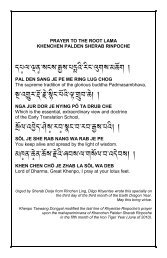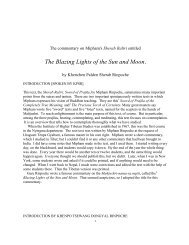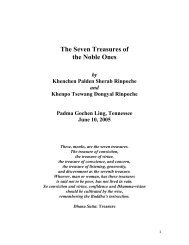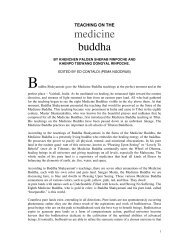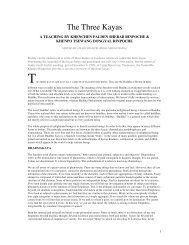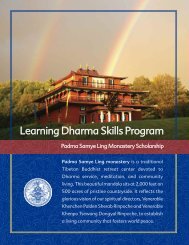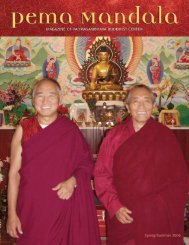6 Pema Mandala Spring 07:Pema Mandala - Padmasambhava ...
6 Pema Mandala Spring 07:Pema Mandala - Padmasambhava ...
6 Pema Mandala Spring 07:Pema Mandala - Padmasambhava ...
Create successful ePaper yourself
Turn your PDF publications into a flip-book with our unique Google optimized e-Paper software.
Bodhisattva<br />
Activity & Conduct<br />
By Venerable Khenchen Palden Sherab Rinpoche and Venerable Khenpo Tsewang Dongyal Rinpoche<br />
Part 1 of a 4-part series of Sutra Teachings excerpted from the Month-Long Dzogchen Intensive at Padma<br />
Samye Ling in March-April, 2006. Edited by Andrew Cook.<br />
During the practice of Dzogchen, we should continually reaffirm<br />
our bodhisattva activities and conduct, since practitioners<br />
of the Great Perfection are always motivated by the resolve to<br />
liberate all sentient beings from the suffering of cyclic existence.<br />
All sentient beings deserve to discover their beautiful, innate<br />
nature, and become happy and joyful. Actually, Dzogchen is the<br />
practice of bodhisattvas, the practice of great love and compassion.<br />
For this reason, we must keep the bodhisattvas’ vast view<br />
and conduct at the center of all our Dharma activities.<br />
To actualize this bodhisattva conduct, we should extend our<br />
inspiration to practice for the benefit of all sentient beings,<br />
aspiring to lead each one of them to complete enlightenment.<br />
Furthermore, our aspirations should not be limited by borders<br />
or restrictions. Buddha Shakyamuni said this many times<br />
throughout his teachings, especially in the sutra teachings and<br />
in the very special prayer known as the The King of Aspiration<br />
Prayers: The Aspiration for Noble Excellent Conduct, which<br />
comes from the Avatamsaka Sutra. He explained that as far as<br />
space extends, so too infinite sentient beings exist. Each and<br />
every one of them has emotions and karma, and is struggling<br />
through the difficulties of samsara and delusion. Therefore, our<br />
aspirations and prayers should be as limitless as space. This is<br />
very important to remember.<br />
But what is the meaning of “aspiration” It means we should<br />
open our hearts by developing love, kindness, and compassion<br />
for all living beings, without partiality or restrictions. On a deep<br />
level, this aspiration represents our courage, commitment, and<br />
willingness to continue along the path for the benefit of everyone.<br />
Although we currently do not have the capability to solve<br />
the problems of all beings, we can generate the willingness to do<br />
so. We are willing to help in whatever way we can, according to<br />
our capabilities. We are ready!<br />
Even if we are unable to solve the problems and difficulties<br />
of others, at least we are developing the intention to be able to<br />
do so in the future, to bring them peace, happiness, and joy in<br />
the state of enlightenment. This is how bodhisattvas think and<br />
how they engage in beneficial conduct, and it also the goal,<br />
vision, and philosophy of Dzogchen practice.<br />
Practitioners who maintain this vast view and willingness to<br />
work for the benefit of all sentient beings are known in the<br />
Mahayana teachings as “bodhisattvas.” In Sanskrit, bodhi means<br />
“enlightenment” and sattva means “courageous.” So, bodhisattvas<br />
are “courageous ones for enlightenment.” The resolve<br />
and willingness to expand one’s love and compassion is itself<br />
enlightenment, or awakened mind. We should maintain our<br />
motivation and intention even when we are disturbed by our<br />
ego-clinging and negativities.<br />
The distinctions between Mahayana and Hinayana practitioners<br />
are not external; they do not relate with how a person<br />
looks, speaks, or dresses. The real difference between these two<br />
types of practitioners is in their vision, their ideas, and their<br />
willingness to attain enlightenment for the sake of beings. For<br />
this reason, the Mahayana and Vajrayana teachings, as well as<br />
the Dzogchen tantras, all distinguish between Mahayana and<br />
Hinayana practitioners based upon their bodhichitta—their<br />
altruistic intention to attain enlightenment and work for the<br />
benefit of limitless sentient beings until everyone reaches the<br />
essence of enlightenment. This is the only distinction.<br />
Otherwise, both Hinayana and Mahayana practitioners are followers<br />
of the Buddha: both practice nonviolence and learn how<br />
to benefit others. What differs is the emphasis they place on the<br />
willingness to help all sentient beings.<br />
If we practice Dzogchen meditation thinking only of ourselves,<br />
our practice is not rooted in the bodhichitta of the<br />
Mahayana path. It is incomplete, inauthentic “Dzogchen.”<br />
Practicing in this way, we are inserting the element of the ego<br />
of the Hinayana mentality into the Mahayana teachings. Thus,<br />
even though we may call ourselves Mahayana practitioners, by<br />
engaging in this type of practice we are, in reality, Hinayana<br />
practitioners.<br />
For all these reasons, the willingness and openness of bodhichitta<br />
are extremely important. These qualities make us good<br />
people, genuine and beautiful beings. By practicing in this way,<br />
we will gradually develop courage and commitment in addition<br />
to patience and tolerance. Each of these is very important for<br />
practitioners as well as everyone else. “Patience” refers to being<br />
more open as opposed to being tight and twisted, afflicted by a<br />
narrow mind and the feeling of being cornered. If we carry this<br />
narrow mental attitude everywhere we go, we will always feel<br />
extremely rigid. Our heads will bounce in every direction! On<br />
the other hand, when we have a more open and vast view,<br />
things can change and move. There is more room for our intel-<br />
12 <strong>Pema</strong> <strong>Mandala</strong> | SPRING/SUMMER 20<strong>07</strong>




